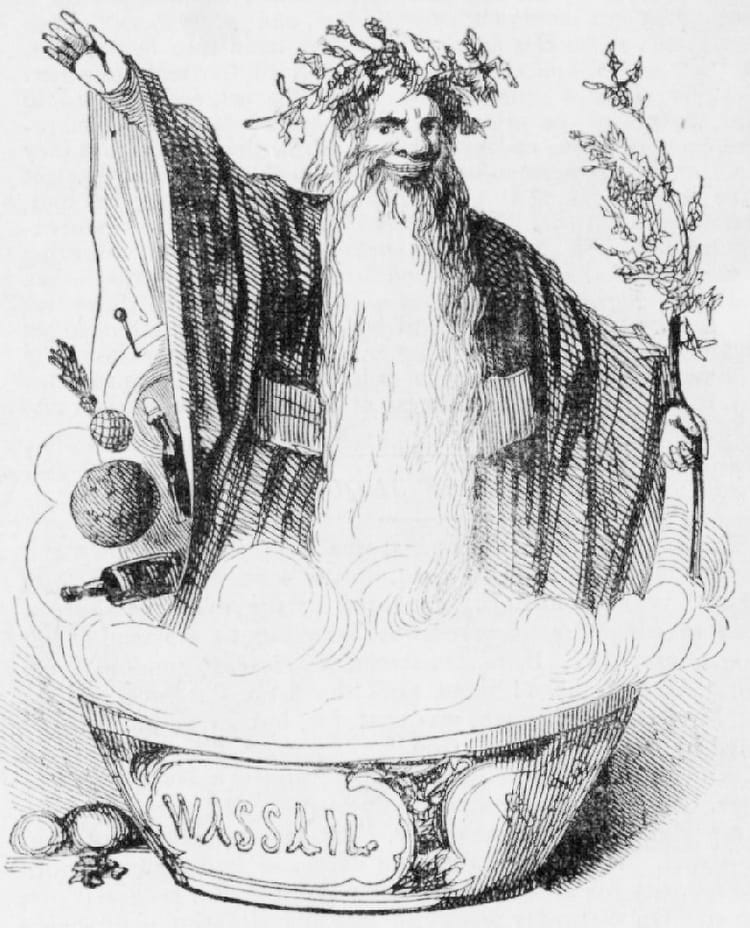New Moon: Flooding the senses

It's Friday. Hello. We are on the very cusp of stepping into what I consider the light half of the year. Day will soon overtake night, and then in the kink that I practice with my owner our balancing of pain and pleasure will tilt more toward the latter; instruments of pain will not go completely unused, but they will be used less, and the pain itself often becomes less violent, inflicted on my flesh not through beatings, thrashings, strikes, or bites, but instead through the enforced stillness of rope. Mostly, simple hedonism is our call, a warm sensuality where any torments are more in the forms of teasing me to frenzy, or where torment itself is absent and I'm drowned in such indulgence that I can be coaxed to submit even more fully to another's will.
But for a few more days, ritually I am still living in the darkness; though our sex and our play are none so rough as when this half of the year began, there's still the possibility of a ferocity, a viciousness, that might render screams and leave bruises. Meanwhile, as my owner isn't the only I've kinked with before and I will likely kink with other people in the future, I'm under no such ritual codes with those others (extant or hypothetical) and in such separate dynamics there can easily arise separate logics for what flavor of kink to enjoy together. Despite the array of contexts that govern my experience as a masochist, however, one theme is pervasive, which is sensory inundation of some sort.
Today I'm trying to compose my thoughts on what that inundation does and means to me. Ideally I could write about this from both sides of the top/bottom slash (for pain specifically or for all sensation play), but since my top side still exists only on paper, I can't speculate too well about the inverses or complements of my experiences with bottoming. So this post may resonate best with fellow bottoms and masochists, or with the kink-curious who suspect they'd fall in that realm. It's also likely to reflect some writing I've already done on FetLife[1] about my bottoming "style," but it won't just be a point-for-point retread because over here I'm not trying to solicit or offer a practical manual. This will be much less systematic, and it centers on flooding the senses as a potential mode of transformative ordeal work.
Terminology
For those reading who aren't immersed in kink, here's a reminder of what I mean when using certain jargon.
- Bottom: The person in a kink scene (activity) who is receiving the action of someone else, e.g. they let someone pour candle wax on them. May also refer to someone who habitually bottoms. (Note how this can be a verb.)
- Top: The person in the scene who is giving an action to someone else, e.g. they're the one pouring the candle wax. May also refer to someone who habitually tops.
- Sub(missive): The person in a scene who does not have much control over what happens in the scene unless they follow a given protocol to withdraw their consent.[2] Although this consent-revoking protocol also is necessary for people in the other roles described above and below, being the submissive party is crucially distinguished through their intentional ceding of power to someone else for as long as their consent remains in effect. "Sub" may also refer to someone who habitually occupies this position. The verb form is "submitting" or "subbing."
- Dom(inant): The person in a scene who has most control over what happens in the scene unless the submissive party withdraws consent. Although the dominant party is still at risk of having their own consent violated, they are crucially distinguished by consolidating enough power to be markedly responsible for the sub's well-being. "Dom" may also refer to someone who habitually occupies this position. The verb form is "dominating" or "domming."
- Switch: Someone who freely moves between bottoming and topping, or between subbing and dominating. This may happen in the context of a single scene or a longer relationship; it may also, as in my case, mean that the switch is comfortable filling different roles with different people, e.g. being constantly submissive with one partner but constantly dominant with another.
There are many nuances that arise within this basic framework. A top is not necessarily a dom, a dom is not necessarily a top, a bottom is not necessarily a sub, and a sub is not necessarily a bottom. It could be and often is the case that the person who submits during one activity is actually the top for that activity, e.g. they give oral sex, or (less obviously) they tie up the other person according to the other's own commands. In those cases the dom is generally the bottom.
Some people also bottom or top for kink but do not incorporate any kind of power exchange. All kink is a collaboration, but various tops and bottoms prefer to keep their collaboration in directly egalitarian frameworks; they may have no rules for someone to follow when they're being whipped, only a straightfoward dialogue about what kind of whipping the top wants to perform and what kind of whipping the bottom wants to feel, both before and during the scene. In these people's cases, we would say they're potentially into s/m (sadomasochism) or b/d (bondage/discipline) but not into D/s (Domination/submission)[3].
Conversely, some people submit or dominate but do not externalize this power through many precise bottoming/topping activities; for instance it may be more arousing for them to demand that their partner wear certain clothing, masturbate some number of times a day, and make them a cocktail every time they visit (or to have those demands made of them), but not particularly arousing to handcuff and spank that same partner, especially not just because that partner failed to fulfill their duties. In these people's cases, we would say they are into D/s but not b/d or s/m.
One other thing to consider with these terms is that people may partake of similar activities for very different reasons. Some people who bottom for s/m activities are like me — we are actual masochists, enjoying the pain itself — and other people bottom for it without having masochistic inclinations. They may simply endure the pain as a matter of devotion to the person offering it, or for other reasons. And some non-masochistic bottoms avoid painful play at all, exclusively preferring gentler sensations. All of this may be understood similarly for sadistic vs. non-sadistic tops, too.
Despite such complexity, hopefully I've presented things clearly enough and can move on. I welcome questions through comments or messages, of course.
Swimming in sensation
As I've written before, what I know of ordeal so far is not anything mutually arranged as such, but instead things which scratch that surface, inculcate that energy. I have known intense experiences that vary between the highly painful, the highly pleasurable, and both. Most of them have relied heavily on touch, but additional sensory elements have also been included, and I prefer when this is the case. I rarely do kink without music in the background, sometimes quiet and sometimes loud to the point of becoming its own participant. Depending on how cruel or kind I expect things to go, my kink music of choice can be anything from metal to classical, EDM to folk, instrumental ambience to formulaic singing.
Food play isn't common for me, but when it does happen I absolutely love tasting, chewing, eating while I experience other sensations with the rest of my body. Once or twice there have been lit candles for not just the illumination but also the smell of beeswax, and as I've started helplessly turning into a scented candle collector (incense being my preference but also giving me headaches) I think this is going to make smell a more common feature in scenes to come.[4]
More generally, my visual stimulation comes vivid electric lighting, either what party hosts have on hand or the programmable "smart" lights my owner and I have installed at home, one of our few concessions to the so-called internet-of-things because as an erstwhile theatre lighting designer I just couldn't resist. Colored lights have a knack for quickly changing one's sense of reality as most of us rely so much on sight. In less than a second I can find myself in a more-than-mundane space through a few taps to configure a few lamps, especially if I also start up a playlist. One of my favorite scenes I've ever taken part in also used lighting more aggressively, as my owner and our friend co-topped me with beatings and other touch-torments while we'd also configured a strobe light to flash in the room with us. Not something that would be neurologically safe for everyone, but I loved every second, and not just because I felt like I was in a David Lynch nightmare.
For all I've written about ordeal and alchemical transformations as a means to break someone or something down, strip a being to its core, experience purification without sin, at the end of the day I'm just not ascetic enough to usually seek that transformation through denial, removal. Deprivation of one sense is only something I can relate to if the point is to enhance the senses I'm left with; deprivation of all senses would be torture so absolute that I doubt I'd ever consent to it. And though I respect the autonomy of people who willingly go through things they outright hate in kink because of myriad reasons, I don't share those reasons. I cannot step into a kink headspace grudgingly; on many occasions I may express nonconsent but I only feel safe doing so as a game, a roleplay, a theatrical exploration, thus the thing to which I'm objecting must ultimately be a thing I want.
Despite that qualifier, even without such an emotionally intense context I prefer to use an opt-out consent model ("keep going unless I tell you not to" and "do anything you want unless I've specifically ruled it out") when I'm in a sensory swirl. For a first scene with someone, or if the other person doesn't enjoy opt-out, I will still bottom for them on an opt-in basis ("pause before each new action so that I can agree to it" or "only do what we specifically agreed you could do in advance, nothing beyond it") — but I do this at some risk to my own psychology. While many people have difficulty trusting a kink or sex partner strongly enough to simply dive in and submit to whatever is thrown at them, I benefit from simply delineating a few key boundaries and then letting the other take the reins in all respects. If I have to refresh my consent continuously, the interruptions place a demand on me to question and analyze my experience, pulling me out of pure somatic processing. That analysis can provoke anxiety, dissociation, and even trauma memories. I feel safer during kink and sex if I can confine the heavy thinking to before and after.
It's a consent model that doesn't work for everyone, maybe not even for most people, but I know I'm not alone in favoring it. It's a small but important twist to what's generally discussed by advocates of appropriate trauma-informed consent practices. My no must be taken seriously, but if my yes isn't also taken seriously I will have related difficulties.
Even when it turns out an activity is challenging for me, I must be allowed to endure that challenge, empowering myself through choosing what I can put up with as much as choosing what I can't. Though every top has the right to suspend our play because of their own concerns or problems (about themselves or about me), I prefer negotiating scenes where the top will be outright dominant — or sadistic enough that they'll be tormenting me for their own reasons, not exclusively hoping to satisfy my needs.[5] Then I have more confidence that if they still prefer check-ins it will be more about common sense during an experiment, and not about invalidating my desire.
Let me feel that trust, that faith. Let me see things through.
Teach me how to drown
If I can ever intentionally embark upon a true ordeal, then seeing things through will be particularly important. That's yet another reason why ordeal must be pursued with mutual intent. The giver of the ordeal must know how important it is — on a (spi)ritual level — for the receiver to complete the experience.
I have yet to plan anything, but I have any number of ideas where sensory inundation is a default. There is an ordeal in my mind by combined forms of pain and overstimulation, much like I've already known but enhanced, elevated, prolonged, stakes raised. I've been hit by various tools for more than an hour, sometimes, but in a formal ordeal I might wish to go longer, and with a greater amount of pain than I normally tolerate. Since the pain that both excites and agitates me the most is very sharp, stinging pain like what comes from thin impact tools, electrical zaps, or the edges of blades, I would hope to rely on those more than usual — and risk bloodletting or maybe even pursue it as I never really have done before. I might likewise accept subcutaneous needles. I might accept fire, the chance of getting singed or burnt; I would be terrified, but the aim would be to face that terror.
There would be loud music, whether recorded or played live. If there were enough other people present, maybe they would chant things. More sound. I think of taste, too — fed a confusingly delicious sacrament, or a horrific one. I could drink wine, and then blood.
An alternative I might plan, though, would not be so violent at all — extreme pleasure through immersion in a warm bath, being surrounded by rich scents, being fed endless sweets, then my body offered for half a dozen other bodies to touch, grope, penetrate, and force to come repeatedly. And there might also be the middle way, the most perverse, the most riotous: the pain ordeal and the pleasure ordeal both together.
I would better plan the sequence of events, and the components, and find participants, if I knew exactly what I meant to accomplish with the ordeal in the first place — something more than knowing I'm called to it. Lately I have been thinking I'll be more likely to suss things out through an ordeal where the participant is just me: that is, a psychonautic journey. I have started making concrete plans to ritually ingest psilocybe mushrooms for the first time.
There will be no steps to that ordeal once the mushrooms are within me, metabolizing, transforming; the ritual beforehand will simply be to contextualize my choice and give a reference point after the trip is over. But it will certainly be an ordeal, whether good or bad, and the not-knowing is also my purpose. I will eat them and I will see what they tell me. I will eat them and let go. For a few hours, I will let myself dissolve as myself, and connect to the fungi, and through the fungi to the land, and see what the land would have of me.
I have a hard limit against waterboarding or other drowning simulations, but a lyric from neofolk band Unto Ashes always comes to mind when I think about such things:
Sinking into warmth
Nothing left but down
Teach you how to swim
Teach me how to drown
Give me so much sensation that I'm swept up by the current and can welcome it overwhelming me, dragged down until the flood ends on its own or a trusted soul can pull me back out.
Engaging in play vs. "doing the work"
It's worth asking at this juncture: what, really, is the value in kink of this intense, potentially traumatic kind? I've written already of the need for rites of passage, and pointed to ordeal work as one route, but that need speaks to generational trauma more than personal, unique traumas — and in this post now I've implicitly suggested that even with the risks, an ordeal of sensory inundation is a potential trauma-healer as much as an inflicter.
I do mean that, based on my ordeal-adjacent experiences to date, but it's a bold claim. Besides the fact that kink's therapeutic qualities are not the same as seeking therapy from an ethical, experienced provider[5], I can imagine people debating the mechanism by which sensory inundation could positively affect a traumatized body-and-mind. Perhaps:
- It could be that through pushing oneself to let go of fear or inhibitions during such a deliberately chosen assault, this lends the strength to be more resilient during future difficult experiences where one's agency is more restricted.
- It could be that although the person receiving so much sensation might appear to be punished, they are at least the center of another's attention, perhaps even multiple others' — and this would provide reassurance that they haven't been abandoned or overlooked, versus the feelings of loneliness and invisibility that trauma tends to induce.
- It could be that bilateral stimulation does something to soothe our nervous systems and help rewire trauma-trodden pathways. This is currently an unproven hypothesis in psychology, but it's increasingly popular and relates to the rise of therapy styles like EMDR (Eye Movement Desensitization and Reprocessing) or EFT (Emotional Freedom Technique).
All of these ideas have merit to me, even the latter despite how EMDR and EFT have some spurious origins and are sometimes touted as miracle trauma cures when that's certainly not true. I can't look down my nose at those practices when I've actually benefited from EMDR myself — mostly I would argue that although bilateral stimulation may not really be why the practice does seem to clinically "work," any sort of heavy stimulation can help create radically distinct somatic realities for a willing participant.
In my own case, I think there is also the very prominent element of autism. Contrary to many stereotypes of autistic living, I can grow "overstimulated" in response to some situations — such as very high pitched noises, or being packed in tightly with other human beings in a transitory environment (e.g. a bus) and not an environment that I deliberately sought (e.g. a nightclub) — but more often my trouble is understimulation. Under that high pitched frequency range, I prefer loud environments to silent ones, whether the noise is from music or from animal calls. I prefer strong food to bland, and lots of visual detail — including flashes or strange colors — to visual monotony. My skin is quite sensitive to touch, but not in a way where stimulating it feels bad; rather it feels quite good, so good that it's dangerous to let just anyone do it. Probably the only sense where I do have to manage input rather carefully is smell, as unpleasant odors seem to have a markedly bad effect on me as I've gotten older.
To use most, if not all of my senses is therefore a welcome adventure, and to engage them feels safer than the alternatives.
As with last week's post, this is potentially part one of longer thoughts later, so I don't have a grand conclusion — these are only some ramblings and meanderings. But I would love to speak of these matters more with any of you, and then write more later.
[1] Regrettable landscape though it is.
[2] This may be through simply saying "no" or "stop," especially if no special arrangement was made in advance; the default protocol of basic human decency is to stop if someone asks. Plenty of kinksters don't play with safewords because they would like "no" to just mean "no." However, many if not most of us still do use safewords, either to rely on a word that hasn't ironically been as devalued as "no" is, or to let ourselves roleplay nonconsent without actually violating our real consent. I always play with a safeword as an emergency release mechanism even if a scene is happening on a more opt-in consent model.
[3] The capitalized vs. lowercase choice sometimes has implications for also referring to a dom as a Dom, reflecting their power over the lowercase sub. It's a convention that I'm fairly inconsistent about following.
[4] I know that having candles "once or twice" in an erotic context may sound odd when candlelight is often considered an erotic paradigm. However, since I've only started to overcome my childhood pyrophobia rather recently — and since I've spent most of my adult life renting dwellings where candles were prohibited anyway — candles are a very new sensory realm for me, though my eagerness is surely accelerating.
[5] As I've possibly affirmed before, healing kink activities are more likely to fulfill their true potential when combined with seeing a therapist, and their own traumatic risks are more likely to be alleviated if therapy is already underway.
Thank you for reading. If you've been following Salt for the Eclipse for a while, I would appreciate if you could consider upgrading to a paid subscription (starting at $1/month), because sending this newsletter every week takes me considerable time that I could be spending writing work under my legal identity that might pay me slightly more if published.
However, Salt for the Eclipse is ultimately a labor of love and even of ritual necessity, so even more than financial support, I appreciate direct responses to what I write; this not only assures me someone is getting something out of my work, but gives me the opportunity to dialogue with other people about the ideas here, instead of simply engaging in self-reflection.
Thanks again. Next week is an Occult-tier paid post specific to Ostara (the spring equinox), and then the week after I'll have a post for all paid readers about my deepening journeys through Celtic and Nordic animism, focusing a little more on the latter than I have before.





Member discussion